Beth Kephart's Blog, page 39
September 17, 2015
My review of Patti Smith's M Train, on New York Journal of Books (Churched! I tell you. Churched!)
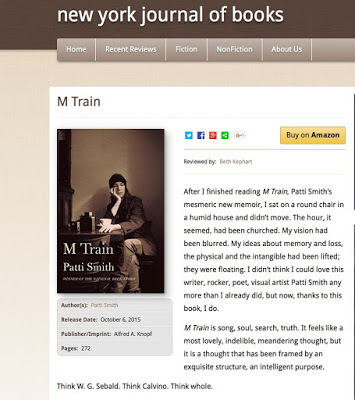 Yesterday, on Huffington Post, I wrote about the importance of structure in memoir. How, indeed, considered structure makes memoir memoir. If we don't care about how the true story gets told, if we don't think broadly, innovatively, wisely about structure, we're only writing autobiography. Telling our story because it's interesting to us, because we feel like talking.
Yesterday, on Huffington Post, I wrote about the importance of structure in memoir. How, indeed, considered structure makes memoir memoir. If we don't care about how the true story gets told, if we don't think broadly, innovatively, wisely about structure, we're only writing autobiography. Telling our story because it's interesting to us, because we feel like talking.Patti Smith understands structure.
Indeed: How much did I love Patti Smith's utterly humble and humbling new memoir, M Train?
TOOMUCHTOSAYTOOMUCHTOWRITETOOMUCHTOOMUCHTHATMUCH.
This is a star who moves quietly through this world, sitting at coffee shops, remembering and thinking. Never drops a name. Never boasts a moment. She is, and she takes us with her.
My thoughts on M Train, in New York Journal of Books, here.




Published on September 17, 2015 12:39
LOVE is now an e-book and the top-ranked local travel book. But wait. How many others are there?
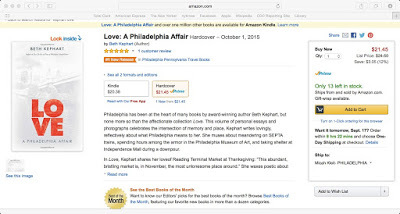 Often repeated, always true: I don't check out my own books on Amazon. I can't change the rankings, can't influence the comments. Anxiety fuels enough of my day. Why add, I wonder, with this?
Often repeated, always true: I don't check out my own books on Amazon. I can't change the rankings, can't influence the comments. Anxiety fuels enough of my day. Why add, I wonder, with this?But yesterday my friends at Temple University Press sent me this graphic with the news that LOVE: A Philadelphia Affair is now an e-book. They also sent the news that LOVE was (at least in that snatch of time) Amazon's top-selling local travel book.
Number 1, I thought. Number 1! I never get to be Number 1 (in anything).
Then, a nano-second later, reality crept in. How many local travel books can there actually be? Is LOVE Number 1, 2, 3, and 4?
With pride, with humility, I'm signing off.




Published on September 17, 2015 04:21
Why structure actually does matter, in memoir
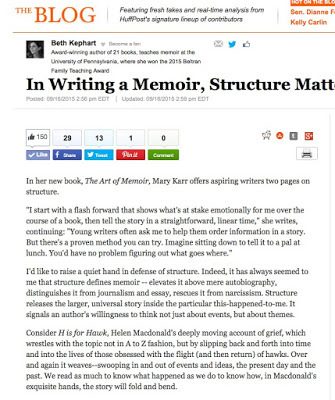 This morning, on HuffPo, I'm reflecting on why structure actually does matter in memoir — how indeed it helps to define the form—to distinguish it from autobiography, essay, war reporting, journalism, because that distinction matters. I refer in the piece to some of my favorite memoirs and memoirists, though there are, of course, many more.
This morning, on HuffPo, I'm reflecting on why structure actually does matter in memoir — how indeed it helps to define the form—to distinguish it from autobiography, essay, war reporting, journalism, because that distinction matters. I refer in the piece to some of my favorite memoirs and memoirists, though there are, of course, many more.And, because I must, I remember my brilliant students at Penn, and one particular Spectacular.
The full link is here.




Published on September 17, 2015 03:50
September 16, 2015
Reflections on the European Migrant Crisis—and a matter that lies at the heart of GOING OVER, on HuffPo
 Today, on HuffPo, I'm reflecting on the European Migrant Crisis—and on a primary theme, the Turkish guest workers, that sparked the writing of my Berlin Wall novel, Going Over (Chronicle Books).
Today, on HuffPo, I'm reflecting on the European Migrant Crisis—and on a primary theme, the Turkish guest workers, that sparked the writing of my Berlin Wall novel, Going Over (Chronicle Books).
The entire piece can be found here.
A brief excerpt, from the end of the piece, below:
When I set out to write my 1983 Berlin Wall novel, Going Over (Chronicle Books, 2014), I thought my research would primarily take me to the divided lives of those on either side of the wall. To the failed attempts at freedom. To the successful passages. To the lives of graffiti artists and stymied stargazers.
I found that. I wrote that. But there was something more, something bigger at the heart of this Berlin story -- the lives of the Turkish immigrants, those "guest workers," who had been called to West Berlin to help mitigate a rising labor problem in the wake of the war. Vaccinated, packed onto planes and trains, and redirected to worlds they couldn't foresee, these Turkish citizens left often-rural homes to become poorly paid semi-skilled laborers on German assembly lines. They were crammed into ghettoized apartments, left to their own societal devices, sometimes despised. Those who sought protection from German police -- women, mostly, seeking to escape abusive marriages or challenging conditions or threats of "honor" killings--were often foiled in their search for help. The Turkish immigrants were resident foreigners. They were a culture within a country, both separate and essential.
This Turkish story, it seemed to me, was as resonant, as relevant, as supremely timely as the story of walls and divisions and political strikes against family life. It contained lessons that even today disrupt ideas about German identity and about diversity -- anywhere, in any country. It had to be written about, to stand beside the better-known Wall story.
Those who are fleeing ravaged homes in Syria, Afghanistan, and elsewhere know only that which they are leaving. They cannot imagine what is next -- who will help them, who will open doors, who will allow them to maintain their dignity. As governments, agencies, and families all around the world watch the exodus in horror and with broken hearts, it becomes an urgent matter to also imagine what happens next.




Published on September 16, 2015 10:37
September 15, 2015
my father's house is now officially for sale (remembered in an excerpt from LOVE)
 Readers of this blog (and friends) know that I've been at my father's side much of this summer, readying his beautiful home for sale.
Readers of this blog (and friends) know that I've been at my father's side much of this summer, readying his beautiful home for sale.That house is now on the market, thanks to the great work of one of my area's most beloved and effective realtors, Marie Gordon. I'm also lucky to count Marie as a neighbor and as a friend.
If you're interested in a fully refurbished, five-bedroom, perpetually-well-cared-for, full-of-natural-light-and-window-boxes home in the Radnor School District—a house that sits up on a hill on a beautiful wooded lot—(or if you know someone who is), please check out this web site (including the amazing video!) and contact Marie.
In the meantime, I share this excerpt from LOVE: A Philadelphia Affair —reflections on the house where I lived from the age of thirteen until I embarked for school, marriage, and motherhood:
We drove—or, rather, our father did. We hardly spoke, save for the short verbs (Look.), the exclamations (Wow.), the necessary adjectives. It was like going to the movies in reverse—we moved, the scenes stayed still. It was like going window shopping, but there was nothing to buy. It was like getting away with something, but hunting for light is never a crime.
Finally, of course, we’d turn back toward the house where our holidays had begun—the house with the half-eaten turkey still in the pan and the gifts unwrapped and the games subverted. In our slow and usually silent approach along the bend of the last road, we could see, for an instant, our own lives lit as mysteriously and spectacularly as the strangers whose homes we’d just spied on. The shimmer of that big tree through the window. The white wings of the angels in the yard. The illuminating lights beneath the twin wreaths.
Who was lucky enough to live there? We were lucky enough to live there. It caught us, fabulously, by surprise.
From a chapter titled “The Lights Fantastic,” LOVE: A Philadelphia Affair




Published on September 15, 2015 11:57
September 13, 2015
celebrating my husband's first gallery showing, at Jam Gallery in Malvern, PA
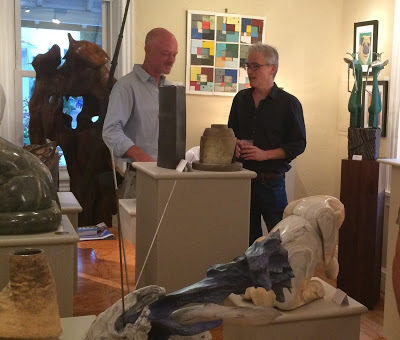
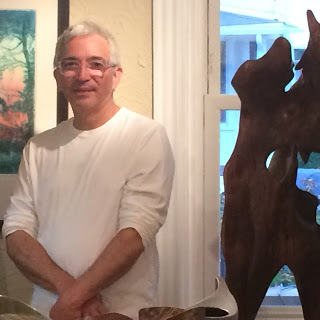
Mario Sulit, my brother-in-law, came in from Dallas to help us celebrate (among other things) my husband's first gallery showing, at Jam Gallery, in Malvern, PA. Bill (pictured in the dark shirt behind two of his pieces and beside sculptor Doug Mott) joined painters, ceramicists, sculptors, egg artists, woodworkers, metal works, and salvaged-wood artist Laura Petrovich-Cheney (whose work—built from the salvaged wreckage of Storm Sandy and incredibly inspiring to me, as the author of the forthcoming storm novel This Is the Story of You— hangs just behind Bill) for what proved to be a wonderful reception and conversation.
Our friend, ceramicist Lisa Lynn, braved the rain and joined us as well.
For more on Bill's work, please visit his web site.
To see his work in person, please visit the very hospitable Jam Gallery, located at 321 East King Street in Malvern, PA.




Published on September 13, 2015 06:22
September 12, 2015
five new dishes, one cake
 With my Salvadoran-born, Dallas-based, court-translator brother, Mario, visiting for the weekend, I wanted to do something new in the kitchen. I decided on a six-tapas picnic and a cake. I also decided (I'm never sure why I do this) to make all things I hadn't made before. With the exception of the cake. I had to have one safe stand-by.
With my Salvadoran-born, Dallas-based, court-translator brother, Mario, visiting for the weekend, I wanted to do something new in the kitchen. I decided on a six-tapas picnic and a cake. I also decided (I'm never sure why I do this) to make all things I hadn't made before. With the exception of the cake. I had to have one safe stand-by.But I also wanted all the dishes to be light, and the purpose of the dishes to be, as Mario says, flavor. As opposed to calories.
And so I had fun in the kitchen yesterday. (Except when my blender working the sixth (and subsequently failed) tapa broke.) Pictured above is one of those simple delicious dishes, which is highly recommended and this easily made: Peel and slice oranges, blood oranges, grapefruits, clementines (if you can find them) and arrange them on a platter. Heat the following ingredients to a nice temperature: dry white wine, lemon juice, amber honey, rosemary, orange zest and grated lemon zest, salt and pepper. Combine the two. Serve.
It's good. It's really good.
Bonus points: it keeps you away from the computer.




Published on September 12, 2015 12:19
September 11, 2015
Can you get it just right the first time? Colm Toibin and John McPhee reflect on the editing process
 The reason it can take me so long to write a single sentence is because I care so much, even in the very first draft, about that single sentence.
The reason it can take me so long to write a single sentence is because I care so much, even in the very first draft, about that single sentence.This, many might say, is a writerly handicap. Just get the story down, they say. Return to it later, they say. Trust the process.
I do return, later. I do write over that sentence, away from that sentence, disappointed with that sentence. But every single time I write a sentence, or rewrite it, or reclaim it from the trash can, I am hoping for nothing less than sentence that is excellently good.
Writing well, every time, is an eternal hope of mine. I have not cracked that egg.
(Even at the very end of the process, when the book is in galleys, I discover sentences that don't work. Or, an editor with a keen eye questions me about passages that had long seemed set in stone. This just happened, in fact, with THIS IS THE STORY OF YOU. We were in galleys. We thought (after finding several troublesome galley matters) that we were done. But Taylor Norman, reading the book with fresh eyes, stopped, thought, and asked: Do you want your "really" here? Is that double "rappel" intentional? Can't we relax her speech on this page? What do you mean, the wind is incidental? Can she call her mother "Mom"? Look. I wrote this book. I'd read it dozens of times. And I didn't see this stuff. It's an ongoing process, refining one's work. And I suspect we're never really done.)
Over the last 24 hours I've read two favorite writers—novelist Colm Toibin and nonfiction genius John McPhee—on the art of getting it right the first time, and then looking again. I share their perspectives here. I learn from both.
Here Hope Whitmore interviews Colm Toibin for the Barnes and Noble Review on, among other things, process:
BNR: I’m interested in your writing process, because much of the power, particularly in Nora, comes from what isn’t said. There is a lot of inference — with her relationship with her mother — for instance. So I was wondering how you refined this, what is your editing process like?
CT: Oh, there’s no editing process. I mean, you just write down what’s needed — what you think is needed. And while I may change words, or pluck things, I mean not much. There’s no actual editing process.
BNR: So you don’t write then cut?
CT: No, you see, that won’t work, because if you don’t get it down right the first time, I mean — it doesn’t mean you don’t have to do editing or re-reading, re-writing, but not editing; meaning I’ll write this long and later on I’ll make it short, that won’t work. That won’t work.
I mean, well, there are writers who do drafts, knowing there will be later drafts, and that works for them, but I don’t do that. It doesn’t mean that there won’t be later drafts, but I write as though I will never get another chance.
Now here is John McPhee in a New Yorker piece called" Omission: Choosing what to leave out." He too is talking about the importance of selection, in the first paragraph. In the second (non-contiguous) paragraph, he is reflecting on greening, a process he teaches his students:
Writing is selection. Just to start a piece of writing you have to choose one word and only one from more than a million in the language. Now keep going. What is your next word? Your next sentence, paragraph, section, chapter? Your next ball of fact. You select what goes in and you decide what stays out. At base you have only one criterion: If something interests you, it goes in—if not, it stays out. That’s a crude way to assess things, but it’s all you’ve got. Forget market research. Never market-research your writing. Write on subjects in which you have enough interest on your own to see you through all the stops, starts, hesitations, and other impediments along the way....Toibin and McPhee—two writers working two genres—are, in different ways, talking about the same thing: caring. There's a discipline to writing that may not seem so glamorous. There's more to this than just concocting story or throwing out an inventive phrase. We select, we refine, we work to get it right. Perfection may be out of reach. But we're lost when our commitment fades.
Green 4 does not mean lop off four lines at the bottom, I tell them. The idea is to remove words in such a manner that no one would notice that anything has been removed. Easier with some writers than with others. It’s as if you were removing freight cars here and there in order to shorten a train—or pruning bits and pieces of a plant for reasons of aesthetics or plant pathology, not to mention size. Do not do violence to the author’s tone, manner, nature, style, thumbprint. Measure cumulatively the fragments you remove and see how many lines would be gone if the prose were reformatted. If you kill a widow, you pick up a whole line.




Published on September 11, 2015 05:04
September 10, 2015
reviewing Mary Karr's THE ART OF MEMOIR in the Chicago Tribune
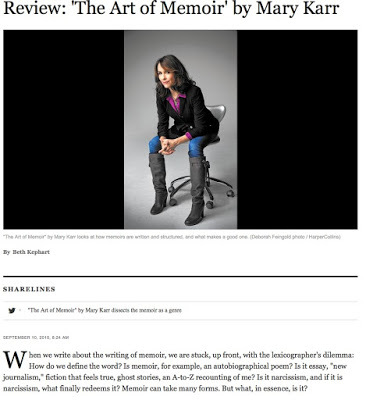
Two years ago, the students in my memoir class at Penn were encouraged to read Mary Karr's The Liars' Club—one of those rare chronologically-told life stories that transcends autobiography to become real-live-brimming-with-wisdom memoir. You can't get much more vivid than Karr does with that Club. (I'm also a fan of Lit; both books are featured in Handling the Truth.) And oh, what discussions her words and stories prompt.
I was delighted when the Chicago Tribune invited me to review Mary Karr's The Art of Memoir. The book, which is full of unexpected riffs on a wide range of topics, is especially helpful to those who may be interested in how Karr made, then contemplated, her three life stories. She reports on the writing process, the vetting process, the after glow, and her right to change her mind in subsequent books on the story she lived.
My Tribune review begins like this, below,
When we write about the writing of memoir, we are stuck, up front, with the lexicographer's dilemma: How do we define the word? Is memoir, for example, an autobiographical poem? Is it essay, "new journalism," fiction that feels true, ghost stories, an A-to-Z recounting of me? Is it narcissism, and if it is narcissism, what finally redeems it? Memoir can take many forms. But what, in essence, is it?and can now be found in full here.
In her new book, "The Art of Memoir," Mary Karr — beloved memoirist and Peck professor of literature at Syracuse University — finds herself foiled in her quest for a "Unified Field Theory" for the category. The "first-person coming-of-age story, putatively true" gave the child Karr hope, she writes. Don DeLillo's thought that "a fiction writer starts with meaning and then manufactures events to represent it; a memoirist starts with events, then derives meaning from them" reinforces, for Karr, that "memoir purports to grow more organically from lived experience." A lifetime of reading and writing memoir has persuaded Karr that it is "an art, a made thing." Memoir, for Karr, is many things. Above all else, she suggests, it is a democratic telling open to anyone who has lived.




Published on September 10, 2015 12:11
so grateful this morning for Serena's thoughts on LOVE
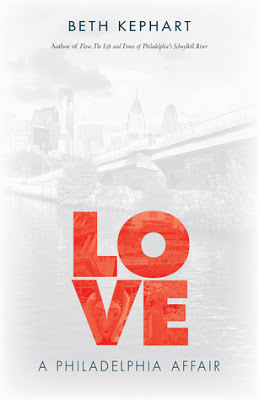 My great appreciation for Serena Agusto-Cox, for being the very first reader (beyond the team and the kind blurbers) of LOVE: A Philadelphia Affair. The very first.
My great appreciation for Serena Agusto-Cox, for being the very first reader (beyond the team and the kind blurbers) of LOVE: A Philadelphia Affair. The very first.What kindness lives in this busy mother, writer, reader, worker.
She has a special knack for finding those ineffable qualities I work toward and hope through in the pages of my books.
I don't want to preempt her. And so I link to her. With greatest thanks.
Savvy Verse & Wit, on LOVE, is here.




Published on September 10, 2015 01:58



